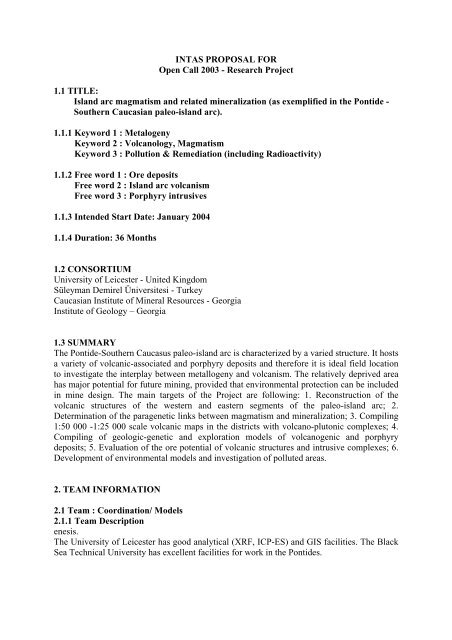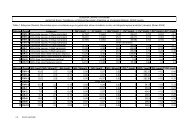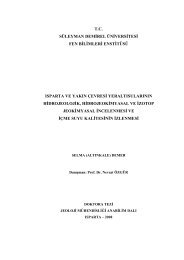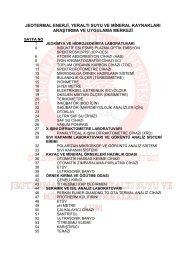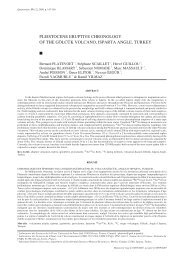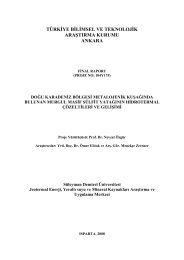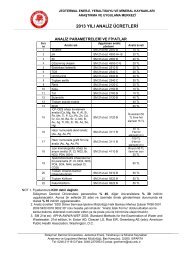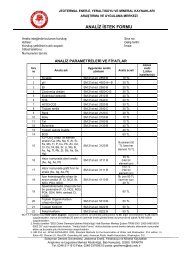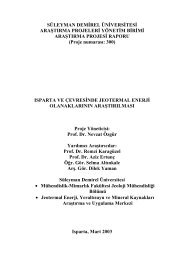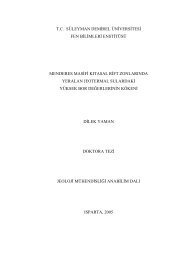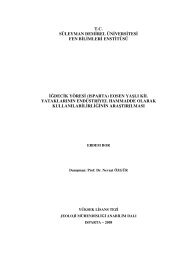Island arc magmatism and related mineralization (as exemplified
Island arc magmatism and related mineralization (as exemplified
Island arc magmatism and related mineralization (as exemplified
You also want an ePaper? Increase the reach of your titles
YUMPU automatically turns print PDFs into web optimized ePapers that Google loves.
INTAS PROPOSAL FOROpen Call 2003 - Rese<strong>arc</strong>h Project1.1 TITLE:<strong>Isl<strong>and</strong></strong> <strong>arc</strong> <strong>magmatism</strong> <strong>and</strong> <strong>related</strong> <strong>mineralization</strong> (<strong>as</strong> <strong>exemplified</strong> in the Pontide -Southern Cauc<strong>as</strong>ian paleo-isl<strong>and</strong> <strong>arc</strong>).1.1.1 Keyword 1 : MetalogenyKeyword 2 : Volcanology, MagmatismKeyword 3 : Pollution & Remediation (including Radioactivity)1.1.2 Free word 1 : Ore depositsFree word 2 : <strong>Isl<strong>and</strong></strong> <strong>arc</strong> volcanismFree word 3 : Porphyry intrusives1.1.3 Intended Start Date: January 20041.1.4 Duration: 36 Months1.2 CONSORTIUMUniversity of Leicester - United KingdomSüleyman Demirel Üniversitesi - TurkeyCauc<strong>as</strong>ian Institute of Mineral Resources - GeorgiaInstitute of Geology – Georgia1.3 SUMMARYThe Pontide-Southern Cauc<strong>as</strong>us paleo-isl<strong>and</strong> <strong>arc</strong> is characterized by a varied structure. It hostsa variety of volcanic-<strong>as</strong>sociated <strong>and</strong> porphyry deposits <strong>and</strong> therefore it is ideal field locationto investigate the interplay between metallogeny <strong>and</strong> volcanism. The relatively deprived areah<strong>as</strong> major potential for future mining, provided that environmental protection can be includedin mine design. The main targets of the Project are following: 1. Reconstruction of thevolcanic structures of the western <strong>and</strong> e<strong>as</strong>tern segments of the paleo-isl<strong>and</strong> <strong>arc</strong>; 2.Determination of the paragenetic links between <strong>magmatism</strong> <strong>and</strong> <strong>mineralization</strong>; 3. Compiling1:50 000 -1:25 000 scale volcanic maps in the districts with volcano-plutonic complexes; 4.Compiling of geologic-genetic <strong>and</strong> exploration models of volcanogenic <strong>and</strong> porphyrydeposits; 5. Evaluation of the ore potential of volcanic structures <strong>and</strong> intrusive complexes; 6.Development of environmental models <strong>and</strong> investigation of polluted are<strong>as</strong>.2. TEAM INFORMATION2.1 Team : Coordination/ Models2.1.1 Team Descriptionenesis.The University of Leicester h<strong>as</strong> good analytical (XRF, ICP-ES) <strong>and</strong> GIS facilities. The BlackSea Technical University h<strong>as</strong> excellent facilities for work in the Pontides.
2.1.2 List of publications1. M Akcay <strong>and</strong> C.J. Moon, 1999, Sampling <strong>and</strong> prediction of the environmental impact ofMining, Pontides, Turkey, 1165-1170 in Mineral Deposits, Processes to Processing, ed C.J.Stanley et al. Balkema.2. C.J. Moon, G. Gotsiridze, V. Gugushvili, M. Kekelia, S. Kekelia, R. Migineishvili, Z.Otkhmezuri, N. Ozgur2001. Comparison of Mineral Deposits between Georgian <strong>and</strong>Turkish Sectors of the Tethyan Metallogenic Belt In Piestrzynski, A. et al. MineralDeposits at the Beginning of the 21st Century, Balkema, 309-3123. C.J. Moon <strong>and</strong> M.K.G. Whateley, 1995. From Prospect to Predevelopment Chapter 5 63-92In An Introduction to Mineral Exploration (ed A.M. Evans). Blackwell Scientific.4. M. Akgay, H.M.Ozkan, C.J. Moon <strong>and</strong> B.C. Scott 1996 Secondary dispersion from golddeposits in West Turkey. J. Geochem. Expl., 56, 197-2185. C.J. Moon, 1999, Towards a more quantitative relationship for the downstream dilution ofpoint source geochemical anomalies, J. Geochem. Expl., 65, 111-132.2.1.3 Team Leader <strong>and</strong> addressTitleDr.PositionLecturerSexMaleDate Of Birth 02/05/1951First NameCharlesPatronic NameFamily NameMoonOrganisation TypePublicOrganisation Registration Nr.Academy / BranchOrganisation / University / Institute University of LeicesterDepartmentGeologyLaboratoryStreet NameUniversity RdNr.Post BoxZip codeLE1 7RHCityLeicesterCountryUnited KingdomPhone1 44/116/2523804Fax1 44/116/2523918Email 1cjm@le.ac.ukEmail 2Website2.1.4 List of Senior Scientists in the team1) First Name MigracPatronic NameFamily NameAkçayYear Of Birth 1965Insitute Black sea Technical University, Trabzon, Turkey
2.1.5 StatisticsNumber of Team Members involved in this project: 2Number of Team Members under 35: 0Number of Team Members who have individually received grants in INTAS projects: 12.2 Team : Süleyman Demirel2.2.1 Team DescriptionThe team is composed of the staff of the Rese<strong>arc</strong>h <strong>and</strong> Application Center for GeothermalEnergy, Groundwater <strong>and</strong> Mineral Resources (RACGEGMR) <strong>and</strong> the staff of the Departmentof the Geological Engineering of the Faculty of Engineering <strong>and</strong> Architecture, all at theSüleyman Demirel University in Isparta, Turkey. The team leader Nevzat Özgur, Head ofRACGEGMR, is professor for Geochemistry <strong>and</strong> Ore Deposits, <strong>and</strong> specialist ofvolcanogenic m<strong>as</strong>sive sulfide deposits <strong>and</strong> fossil geothermal systems. The other teammembers are <strong>as</strong> follows: Nuran Sönmez, born 1957, h<strong>as</strong> a Ph.D from 9 Eylul University onGordes (Manisa) pegmatoids, is a fellow rese<strong>arc</strong>her at RACGEGMR . She works in the fieldof mineralogy <strong>and</strong> petrography <strong>and</strong> an experienced fluid inclusion specialist for m<strong>as</strong>sivesulfide deposits <strong>and</strong> epithermal <strong>mineralization</strong>s. Omer Elitok, born 1968, h<strong>as</strong> a Ph.D fromSuleyman Demirel University on geology, mineralogy <strong>and</strong> petrography of Sarkikaraagaç(Isparta) <strong>and</strong> environs, is also a fellow rese<strong>arc</strong>her at RACGEGMR.<strong>and</strong> a lecturer at theDepartment of Geological Engineering. He is a mineralogist, <strong>and</strong> specialist of thin sectionmineralogy with respect to hydrothermal alteration of m<strong>as</strong>sive sulfide deposits. Oya Cengiz,h<strong>as</strong> a Ph.D from Suleyman Demirel University on Barite deposits <strong>and</strong> their genesis betweenSarkikaraaga? (Isparta) <strong>and</strong> Doganhisar (Konya), is a lecturer at the Department of GeologicalEngineering. She is an experienced geochemist for trace element evaluation <strong>and</strong> interpretationin addition to sulfur isotope geochemistry. Menekse Zerener, h<strong>as</strong> a M.Sc. from SuleymanDemirel University, is working for her Ph.D degree at RACGEGMR <strong>and</strong> experienced in fluidinclusion study. In accordance with the other work teams, the team two (Geochemistry) willfulfill following t<strong>as</strong>ks: (1)Study of Cu deposits of Kure (Asikoy <strong>and</strong> Bakibaba) <strong>as</strong> a Cyprustype ore deposit, Cu deposits of Madenköy, Lahanos <strong>and</strong> Cerattepe of Kuroko type, Cudeposits of Madneuli (Georgia) <strong>and</strong> porphyr Cu deposits of Alaverdy (Armenia) with respectto rock <strong>and</strong> ore geochemistry, hydrothermal alteration, ore microscopy <strong>and</strong> fluid inclusionme<strong>as</strong>urements, <strong>and</strong> (2)comparison the deposits with each other <strong>and</strong> elaboration thereconstruction of the metallogenic evolution of the regions of the E<strong>as</strong>t Pontic metallotect <strong>and</strong>its prolongation in the Lesser Cauc<strong>as</strong>us. The team two is equipped with (i) Atomic absorptionspectrometry (Perkin Elmer Aanalyst 800?), (ii) X-ray diffractometer (PHILLIPS X'PertPRO), rese<strong>arc</strong>h microscope with image analysis system <strong>and</strong> fluid inclusion system (LinkamMDS 600).2.2.2 List of publications1. Volcanogenic m<strong>as</strong>sive sulfide deposits in the E<strong>as</strong>t Pontic metallotect, NE Turkey, Ozgür,N., 1993, Resource Geology Special Issue 16, p. 181-185.2. Geochemical pathfinder elements of the Murgul copper deposit, NE Turkey, Ozgur, N.,1993, Resource Geology Special Issue 16, p. 164-169.3. Active <strong>and</strong> extinct geothermal systems in the continental rift zones of the Menderes M<strong>as</strong>sif,Western Anatolia, Turkey, Ozgür, N., 1999, Stanley et al. (eds.) Proc. 5th Biennial SGAMeeting <strong>and</strong> 10th Quadrennial IAGOD Symposium: Mineral Deposits: Processes toProcessing, 22-25 August 1999, London, UK , p. 559-562.4. Geochemical signatures of the Kızıldere geothermal field, Western Anatolia, TurkeyÖzgür, N., 2002, International Geology Review 44, p. 153-163.
5. Relationship between alteration, rare earth element distribution, <strong>and</strong> <strong>mineralization</strong> of theMurgul copper deposit, northe<strong>as</strong>tern Turkey, Schneider, H.-J., Özgür, N., <strong>and</strong> Palacios,C.M., 1988, Econ. Geol. 83, p. 1238-1246.2.2.3 Team Leader <strong>and</strong> addressTitleProf.PositionHead of laboratorySexMaleDate Of Birth 01/09/1953First NameNevzatPatronic NameFamily NameOzgurOrganisation TypePublicOrganisation RegistrationNr.Academy / BranchOrganisation / University / Süleyman Dem|re| ÜniversitesiInstitute'DepartmentgeologyLaboratoryRese<strong>arc</strong>h <strong>and</strong> Application for Geothermal Energy Centerfor GeothermalStreet NameNoneNr.NonePost BoxZip code 32260CityIspartaCountryTurkeyPhone 1 90/246/2111613Phone 2 90/246/2111210Fax 1 90/246/2371666Email 1noezguer@mmf.sdu.edu.trEmail 2geotherm@sdu.edu.trWebsitegeotherm.sdu.edu.tr2.2.4 List of Senior Scientists in the team2.2.5 StatisticsNumber of Team Members involved in this project: 5Number of Team Members under 35: 2Number of Team Members who have individually received grants in INTAS projects: 12.3 Team : Ore geology2.3.1 Team DescriptionThe team consists of rese<strong>arc</strong>hers of the Cauc<strong>as</strong>ian Institute of Mineral Resources (CIMR),Tbilisi State University <strong>and</strong> Geological Institute As. Sci. Georgia. It is represented by 1.doctor of Science, head of department of metallogeny of CIMR, ore-geologist, specialist ofvolcanogenetic nonferrous <strong>and</strong> copper-molybdenum-porphyry deposits. He is experienced incompilation of paleo-volcanologic maps; 2.c<strong>and</strong>idate of science head of thermo-barogeochemistry sector, geochemist, mineralogist, specialist of elaboration genetic <strong>and</strong>thermodynamic models of ore deposits; S.Zurab Laoshvili, 1953 year born, fellow rese<strong>arc</strong>herof the geomorphology department of Tbilisi State University, specialist in compiling of
various type maps <strong>and</strong> creation for them in CIS; 4.Kakhaber Koiava, 1976 year born fellowrese<strong>arc</strong>her of Geological Institute As. Sci. Georgia, specialized on volcanogenetic deposits,S.Alex<strong>and</strong>er Razmadze, born 1974 year, senior worker of Geological Institute As. Sci.Georgia specialized in the lithology, stratigraphy <strong>and</strong> paleontology. According the Project theteam undertakes the following works: study of copper-pyrite Cyprus type deposit (Turkey)<strong>and</strong> epigenetic volcanogenetic <strong>and</strong> copper-porphyry deposits of Alaverdy mining district(Armenia) <strong>and</strong> elaboration of genetic <strong>and</strong> prospecting models in cooperation with other teams.The team proposes to evaluate the ore potential of volcanic <strong>and</strong> intrusive complexes, in whichsome of its members have much experience in prognosis of <strong>mineralization</strong>. The teampossesses the following laboratory equipment: 1) Complex apparatus for thermometricalexplorations (temperature variance 1000 -4500); 2) Complex apparatus for cryometricexplorations (temperature variance -1700 +3000); 3) Vacuum Decriptometer with g<strong>as</strong>chromatographicalprefix (temperature variance of g<strong>as</strong>eous extraction to 8000); 4) Ultra-violetmicroscope; 5) Equipment of atomic-absorption analysis; 5) Spectrometer for quantitativeanalysis DFS-8.2.3.2 List of publications1 1. Geodynamical regimes <strong>and</strong> ore formation (setting an example of Cauc<strong>as</strong>us Region). S.Kekelia ,A. Ambpkadze - Native Geology. 1993. #2. P. 12-20.2 2.Metallogeny of are<strong>as</strong> of interactions of microplates. T. Janelidze , S. Kekelia , A.Ambokadze. -Native Geology. 1996. #1. P. 48-523 3.Geodynamic principals of Metallogenic analyses for Mountain folded are<strong>as</strong> (on theexample of the Cauc<strong>as</strong>ian region). S. Kekelia, M. Kekelia, R. Kofmann. -Georgian Academyof Sciences, A. Janelidze Geological Institute Proceedings New Series, vol. 115, Tbilisi, 2000,pp 372-382.4 4.Geology <strong>and</strong> forming conditions of volcanogenic deposits of nonferrous metals ofPontides <strong>and</strong> the Cauc<strong>as</strong>us. S. Kekelia, M. Kekelia. - Georgian Academy of Sciences,Geological Institute Proceeding, New Series, 2002, vol. pp. 430-442.5 5.Volcanogenic Non-Ferrous Deposits of the Bolnisi Mining District, Georgia, <strong>and</strong> SomeProblems of their Genesis. S. Kekelia. - Electronic version, Site: www.mineralresources.ge,2002.2.3.1 Team Leader <strong>and</strong> addressTitleDr.PositionAcademicianSexFemaleDate Of Birth 20/04/1936First NameSergoPatronic NameAmberkiFamily NameKekeliaOrganisation TypePublicOrganisation Registration Nr.Academy / BranchOrganisation / University / Institute Cauc<strong>as</strong>ian Institute of Mineral ResourcesDepartmentMetallogenyLaboratoryStreet NamePali<strong>as</strong>hviliNr. 85
Post Box 380062Zip codenoneCityTbilisiCountryGeorgiaPhone 1 995//230761Phone 2995//797S36Fax 1 995/32/330746Email 1kekelia_sergo@mail.ruEmail 2Website2.3.4 List of Senior Scientists in the team1) First Name VladimirPatronic NameZinoviFamily NamelaroshevichYear Of Birth 1948InsituteCauc<strong>as</strong>ian Institute of Mineral Resources2.3.5 StatisticsNumber of Team Members involved in this project: 5Number of Team Members under 35: 2Number of Team Members who have individually received grants in INTAS projects: 12.4 Team : Volcanology2.4.1 Team DescriptionThe team comprises rese<strong>arc</strong>hers of Geological Institute Ac. Sci.1. Professor, Dr.sci., Principal rese<strong>arc</strong>h scientist of the Geological Institute Ac. Sci.Georgia specialized in volcanology <strong>and</strong> ore geology, studied the relation of volcanismwith hydrothermal alteration <strong>and</strong> <strong>mineralization</strong> experienced in surveying of volcanicare<strong>as</strong>;2. c<strong>and</strong>-sci. head of the geochemical sector of Geological Institute Ac. Sci. Georgia,experienced geochemist, studied geochemistry of <strong>magmatism</strong> <strong>and</strong> volcanics of variousgeodynamic settings;3. Nona Gagnidze (born 1963) fellow rese<strong>arc</strong>her of the Geological Institute, specializedin volcanology <strong>and</strong> lithofacies analyses of volcanic sequences;4. Onise Enukidze (born 1970) fellow rese<strong>arc</strong>her, specialist of survey of volcanic are<strong>as</strong>.5. Nino Sadradze (born 1968) studied Lithology of volcanic-sedimentary orebearingsequences.The team will study mineralized volcanic-structures in various geodynamic settings, such <strong>as</strong>oceanic sequences including Cyprus type Asikoy deposit of Kure complex, <strong>as</strong> well <strong>as</strong> Kurokotype <strong>and</strong> VMS deposits <strong>and</strong> copper-porphyry deposits of Pontides (Cayeli, Lahanos,Cerattepe, Guzelyala). The investigation will be conducted in cooperation with Team 1 <strong>and</strong> 2.As well <strong>as</strong> will be studied epigenetic deposits of Bolnisi mining district (Lesser Cauc<strong>as</strong>us).The ore potential of the objects will be evaluated <strong>and</strong> genetic <strong>and</strong> ore-geologic models of thedeposits will be created. The team possesses the following laboratory equipment: 1)Equipment for the determination of content of elements by the atomic-absorptionspectrometry method: Perkin-Elmer-305B, Carl-Zeiss FFS-3, Perkin-Elmer-300, PGS-2,Perkin-Elmer-355, Hitachi 180-80; 2) Diffractometer X-ray DRON-2; 3) X-ray fluorescenceanalyser KRF-18.
2.4.2 List of publications1 1. V. Gugushvili. Crust <strong>and</strong> mantle influence on the origin of various types of sulfidedeposits. Bulletin of the Georgian Academy of Sciece, 163 ?3, 2001, pp. 491-494.2 2. V. Gugushvili, I. Hart, M. Natsvlishvili, R. Akhvlediani. Origination of the gold<strong>mineralization</strong> <strong>and</strong> wall rock alteration at the Sakdrisi deposit (Bolnisi miningdistrict). Bulletin of the Georgian Academy of Sciece, 163, ?1, 2001, pp 96-99.3 3. V. Gugushvili, M Kekelia. Cristal <strong>and</strong> mantle sources of Cretaceous volcanism <strong>and</strong>sulfide maneralization of the Bolnisi mining district. A. Janelidze Geological InstituteProceedings New Series, vol. 116, Tbilisi, 2001, pp 311-324.4 4. V. Gugushvili. Ore formation <strong>and</strong> volcanism against the background of geodynamicactivity of the Tethys ocean within the limits of the Cauc<strong>as</strong>us <strong>and</strong> Turkey. A. JanelidzeGeological Institute Proceedings New Series, vol. 115, Tbilisi, 2000, pp 387-4025 5. V. Gugushvili. Madneuli <strong>and</strong> Tsiteli Sopeli, the new type of the Tumiscent (precursor)sulfide deposits, A. Janelidze Geological Institute Proceedings.Tbilisi 1998, pp 223-233.2.4.3 Team Leader <strong>and</strong> addressTitleProf.PositionHead of unitSexFemaleDate Of Birth 17/12/1934First NameVladimirPatronic NameIvanFamily NameGugushviliOrganisation TypePublicOrganisation Registration Nr.Academy / BranchGeorgian Academy of SciencesOrganisation / University / Institute Institute of GeologyDepartmentVolcanology, lithology <strong>and</strong> sedimentologyLaboratoryStreet Name Alexidze 9/1Nr. 9/1Post BoxZip code 380093CityTbilisiCountryGeorgiaPhone 1 995/32/33 26 33Fax 1 995/33/33 07 46Email 1gugushvili34@yahoo.comEmail 2Website2.4.4 List of Senior Scientists in the team1) First Name MarenPatronic NameAmberkiFamily NameKekeliaYear Of Birth 1933InsituteInsitute of geology, Georgian Academy ofSciences
2.4.5 StatisticsNumber of Team Members involved in this project: 5Number of Team Members under 35: 2Number of Team Members who have individually received grants in INTAS projects: 23 OBJECTIVES3.1 RESEARCH OBJECTIVESThe Alpide paleo-isl<strong>and</strong> <strong>arc</strong> of Pontides <strong>and</strong> Southern Cauc<strong>as</strong>us is one of the best are<strong>as</strong> inEur<strong>as</strong>ia to examine the development of volcanism above a subduction zone <strong>and</strong> the formationof <strong>related</strong> mineralisation. Economic volcanic <strong>as</strong>sociated m<strong>as</strong>sive sulphide deposits (VMS) <strong>and</strong>epigenetic polymetallic gold-bearing deposits <strong>as</strong> well <strong>as</strong> porphyry copper-gold deposits occurin the volcanic sequences.The objectives of the Project are also economic, aiming at developing realistic geologicalmodels to aid exploration for the mining industry in an underdeveloped area. Environmentalmodels are also required at Murgul (Pontides) <strong>as</strong> well <strong>as</strong> Madneuli <strong>and</strong> Shamlug (LesserCauc<strong>as</strong>us) to underst<strong>and</strong> the impact of these mines.The Project proposes detailed investigation (petrological, paleo-volcanological, lithofacies,geochemical <strong>and</strong> mineralisation) of volcanic structures of the western (Turkey) <strong>and</strong> thee<strong>as</strong>tern (Georgia, Armenia) sections of the paleo-isl<strong>and</strong> <strong>arc</strong>. The main objectives of theinvestigation are following:1. Reconstruction of volcanic structures of both the western <strong>and</strong> e<strong>as</strong>tern sections of thepaleo-<strong>arc</strong> (sections are distinguished by volcanic sedimentation <strong>and</strong> ore<strong>mineralization</strong>).2. Determination of the paragenetic relation of <strong>magmatism</strong> with <strong>mineralization</strong>.3. Compilation of volcanological maps (1:5 000 - 1:25 000 scales) with VMS deposits(Asikoy <strong>and</strong> Cayeli Cerattepe -Pontides) <strong>and</strong> epigenetic b<strong>as</strong>e metal deposits (Bolnisi<strong>and</strong> Alaverdy mining districts of Eesser Cauc<strong>as</strong>us). The are<strong>as</strong> contain different stylesof <strong>mineralization</strong>.4. Development of geologic-genetic <strong>and</strong> exploration models of volcanogenic <strong>and</strong>porphyry deposits with different styles of <strong>mineralization</strong>.5. Evaluation of ore potential of the paleo-isl<strong>and</strong> <strong>arc</strong> volcanic structures.6. Investigation of environmental impact in the vicinity of producing mines3.2 Background <strong>and</strong> JustificationBackgroundThe Pontide-South Cauc<strong>as</strong>ian paleo-isl<strong>and</strong> <strong>arc</strong> is an extension of the well-mineralisedCarpathian system. The <strong>arc</strong> can be divided into two sections that are separated by a, later,thick sequence of Neogene volcanics. Structural facies investigations (Yilmaz et al. 2000)determined, that the western (Pontides) <strong>and</strong> e<strong>as</strong>tern (Lesser Cauc<strong>as</strong>us) sectors differ in thecharacter of their geodynamic development, the nature of the volcanism, <strong>as</strong> well <strong>as</strong> in theintensity of volcanic activity <strong>and</strong> styles of <strong>mineralization</strong>.The <strong>arc</strong> is bounded on the south by continental slivers, of probable Gondwana origin, whichpossibly also form the b<strong>as</strong>ement of the <strong>arc</strong> (Robinson, 1997). Volcanism in the western part ofthe <strong>arc</strong> is dominated by a thick <strong>and</strong>esite sequence of upper Cretaceous age. Tri<strong>as</strong>sic volcanismis in the form of allocthonous are<strong>as</strong> of b<strong>as</strong>ic volcanics (Ustaomer & Robertson, 1993). Incontr<strong>as</strong>t, the Lesser Cauc<strong>as</strong>us sector h<strong>as</strong> <strong>and</strong>esite volcanism of both Bajocian <strong>and</strong> upperCretaceous age. Following collision a thick (particularly in W Georgia) section of Eocenevolcanics, w<strong>as</strong> generated in a rift environment. Although geophysical data indicate that the E
Pontide section continues to the NE, the exact nature of the correlation with the LesserCauc<strong>as</strong>us is in doubt. Yilmaz et al. (2000) proposed a continuation along strike. In contr<strong>as</strong>t,Akdeniz et al, (2000), suggested that a major fault offsets the e<strong>as</strong>tern Pontides <strong>and</strong> cor<strong>related</strong>a section around Giimushane with the Bolnisi area.In contr<strong>as</strong>t to the Carpathian <strong>arc</strong>, volcanic-<strong>as</strong>sociated m<strong>as</strong>sive sulphide deposits (VMS) arethe dominant type of economic deposit, although vein Au deposits <strong>and</strong> porphyries have been,<strong>and</strong> are being, investigated, <strong>as</strong> well <strong>as</strong> minor skarns <strong>and</strong> Mn deposits (Engin et a/.,2000; Moonet al, 2001).VMS deposits occur in a variety of forms: Asikoy (Cyprus style) (Guner, 1980), Kuroko styledeposits such <strong>as</strong> Cayeli (Hobbs, 2000) <strong>and</strong> Lahanos; gold-rich variants such <strong>as</strong> Cerattepe(Ciftehan & O'Brien 1998) (Pontides) <strong>and</strong> Madneuli (Lesser Cauc<strong>as</strong>us); epigenetic styles such<strong>as</strong> Murgul (Pontides) <strong>and</strong> Kafan, Alaverdy <strong>as</strong> well <strong>as</strong> barite-rich deposits in the Bolnisi district(Lesser Cauc<strong>as</strong>us).The re<strong>as</strong>on for the generation of the different styles of deposits is not understood in detail butis probably due to differences in water depth, sources of fluids (magmatic or sediment) <strong>and</strong>fluid pathways. Deposits such <strong>as</strong> Asikoy, Cayeli <strong>and</strong> Lahanos probably represent deep- watersettings where<strong>as</strong> Alaverdy <strong>and</strong> Madneuli probably formed in shallower water sediments. Fluidinclusion investigations at Madneuli give temperature for copper ores of 370-260° C, forbarite-polymetallic ores on 270°-180°C (Kekelia et. al, 1993) <strong>and</strong> deep drilling h<strong>as</strong> cutintrusives underneath the deposit. The Murgul ores currently mined are predominantly of thestockwork type <strong>and</strong> have been suggested <strong>as</strong> transitional to porphyry coppers deposits byOzgiir (1993). Gold ocurs in many VMS deposits but deposits such <strong>as</strong> Cerattepe <strong>and</strong>Madneuli appear to have epithermal overprints. More conventional vein Au deposits arepresent both in upper Cretaceous volcanics, such <strong>as</strong> Altintepe, near Fatsa (Curtis, 2002).The larger deposits VMS are very significant. At Cayeli, for example, 7.35 Mt of ore hadbeen mined to 2002 <strong>and</strong> reserves are put at 16.9 Mt of 3.8% Cu, 5.8% Zn, 0.5 g/t Au <strong>and</strong> 47g/t Ag (Inmet Mining, 2003). A further resource of 2.9 Mt is inferred. Madneuli <strong>and</strong> Murgulboth contained >70 Mt of ore before mining <strong>and</strong> Madeuli is currently being mined for gold.The Alaverdy deposits are current under rehabilitation by a private sector group.Porphyry deposits in the <strong>arc</strong> occur in a variety of forms <strong>and</strong> ages. Both Cu-Mo <strong>and</strong> Cu-Autype have been discovered in the Pontides <strong>and</strong> Lesser Cauc<strong>as</strong>us (Ratman et al, 1985). Mooreet al. (1980) suggested a modal age of ~80 Ma for Pontide granitic <strong>magmatism</strong> with laterph<strong>as</strong>es at 45 <strong>and</strong> 25 Ma. Exploration in the Artvin area h<strong>as</strong> defined a Au-rich porphyry,temporally <strong>as</strong>sociated with the rift stage (Gumushane dated <strong>as</strong> Eocene (K/Ar: 51-54 Ma,Rockl 1998). In the Lesser Cauc<strong>as</strong>us, porphyries are present at depth in the Bolnisi area <strong>and</strong>outcrop in the Alverdy district. The younger porphyries in southern Armenia are not <strong>related</strong> tothe Pontide <strong>arc</strong> <strong>and</strong> are not the subject of the current project.The Pontides <strong>and</strong> Lesser Cauc<strong>as</strong>us are relatively deprived are<strong>as</strong> of Turkey <strong>and</strong> Georgia <strong>and</strong>both are<strong>as</strong> are experiencing population outflow. Mining represents an opportunity fordevelopment. However, many previous mines have been responsible for unacceptable impactson the environment. Some information (Akcay <strong>and</strong> Moon, 1999; submitted) provide someinformation on the Pontides. Acid Mine Drainage is a major result of open pit VMS in Turkey<strong>and</strong> is also known from Georgia (DAI, 2003). The eventual impact of mining is a combinationof the nature of deposits <strong>and</strong> mining practice. The modern Cayeli operation h<strong>as</strong> relatively littleimpact because of the disposal of tailings at depth in the Black Sea. Murgul is one of thepollution hot spots within the Black Sea b<strong>as</strong>in <strong>as</strong> there is no tailings facility <strong>and</strong> tailingseventually are deposited in the estuary of the Coruh river on the outskirts of the majorGeorgian city of Batumi.
More detailed analytical data is required from a range of VMS <strong>and</strong> porphyry deposit to buildmore detailed environmental models to highlight are<strong>as</strong> for amelioration <strong>and</strong> improve thedesign of future mines.In summary the following questions need to be solved:• Character of geodynamic setting, lithofacies <strong>and</strong> geochemical characteristics ofmineralized volcanostructures consist of VMS <strong>and</strong> epigenetic ores of nonferrous noblemetals.• PT condition scale of formation of various styles of <strong>mineralization</strong>.• The sources of <strong>mineralization</strong>: host rocks or magmatic fluids?• To generate realistic exploration models for deposits in the Pontide -SouthernCauc<strong>as</strong>ian <strong>arc</strong>.ReferencesAKCAY, M & MOON, CJ. 1999. Sampling <strong>and</strong> prediction of the environmental impact ofmining: Pontides, Turkey 1165-1170 In: Stanley, C.J. et al. Mineral Deposits:Processes to Processing. Balkema.AKCAY, M & MOON, C.J. (In review). The environmental impact of mining in the Pontides,Turkey: reconnaissance sampling <strong>and</strong> GIS b<strong>as</strong>ed prediction Geochemistry:Environment, Exploration, Analysis. AKDENIZ, N., HASANOV, H. & NAGIYEV,V. 2000. Correlation of northe<strong>as</strong>tern Anatolia <strong>and</strong> lesser Cauc<strong>as</strong>us: A new approach tothe geology of the Pontides. 75' Anniversary MTA conference, Ankara, 173-191. (InTurkish)ClFTEHAN, H. & O'BRIEN, N. P. 1998. The Cerattepe Cu-Au-Ag deposit. Abstract 3rdSymposium Geology- of Turkey, 153CURTIS, L. 2002. Altin Tepe Gold Property. Unpublished Report, www. odysseyresources.com.DEVELOPMENT ALTERNATIVES 2003. Water Management in the south Cauc<strong>as</strong>us.www.daiwater.comENGIN, T., OZKAN,Y, §ENER, F. & TOPRAK, B. 2000. Metallogenic Map of Turkey.MTA.GUNER, M. 1980. Sulphide ores <strong>and</strong> geology of the Kiire area. Pontides (M Turkey/ M. T AEnstitusu Biileteni, 93-94, 65-109.HOBBS, J. B. M. 2000. Geology of Cayeli Mine. Unpub Ms. Irish Association ofEexploration Geologits Conference, Galway, Irel<strong>and</strong>. 9pp.KEKELIA S.A., AMBOKADZE A.H. & RATMAN, J.P. (1993) - Volcanogenic deposits ofnon-ferrous metals of paleo-isl<strong>and</strong>-<strong>arc</strong> systems <strong>and</strong> methods of their prognosis.Tbilisi. Metsniereba Publ., 96 p. [in Russian].MOON, C.J. GOTSIRIDZE, G. , GUGUSHVILI, V., KEKELIA, M., KEKELIA, S.,MIGINEISHVILI, R., OTKHMEZURI, Z. & OZGUR, N. 2001. Comparison ofMineral Deposits between Georgian <strong>and</strong> Turkish Sectors of the Tethyan MetallogenicBelt In Piestrzynski, A. et al. Mineral Deposits at the Beginning of the 21st Century,Balkema, 309-312.MOORE, W.J., MCKEE, E.H. & AKTNCI, O. 1980. Chemistry <strong>and</strong> chronology ofplutonic rocks in the Pontid mountains, Northern Turkey. In Jankovic, S & Sillitoe R.(eds) European Copper Deposits: 209-216. Belgrade.OZGUR, N. 1993. Volcanogenic m<strong>as</strong>sive sulphide deposits in the e<strong>as</strong>t Pontic metallotect.Resource Geology 17: 180-185.RATMAN, I.P., KEKELIA, S.A. & NAROZAULI, I.G. 1985. Zoning of porphyry coppermolybdenumdeposits <strong>related</strong> to diorite-tonalite-plagiogranite complexes (<strong>as</strong> an
example of the Tekhut deposit, Armenian SSK). All-Union Mineralogical SocietyTrans., 3. p. 167-168. [in Russian].ROBINSON, A.G. ed., 1997. Regional <strong>and</strong> Petroleum Geology of the Black Sea<strong>and</strong>Surrounding Region: AAPG Memoir 68. 53-62.ROCKL. L.O. 1998. The Geology <strong>and</strong> Genesis of a Gold-rich. Copper Porphyiy Occurrencein the e<strong>as</strong>tern Pontids, NE-Turkey. Unpub. Ph.D. Thesis, University of Southampton.USTAOMER, T. & ROBERTSON, A.H.F. (1993) - Late Paleozoic-Early Mesozoic marginalb<strong>as</strong>ins along the active southern continental margin of Eur<strong>as</strong>ia: evidence from theCentral Pontides (Turkey) <strong>and</strong> adjacent regions. GeologicalJournal, 120, p. 1-20.YILMAZ, A., ADAMIA, Sh, CHABUKIANL A., CHKHOTUA, T., ERDOGAN, K.,TUZCU, S., & KARABIYIKOGLU, M., 2000. Structural correlation of the southernTranscauc<strong>as</strong>us (Georgia)-e<strong>as</strong>tern Pontides (Turkey). In: Bozkurt, E., Winchester, J. A.&Piper, J. D. A. (eds) Tectonics <strong>and</strong> Magmatism in Turkey <strong>and</strong> the surroundingArea.Geol. Society, London, Special publications. 173, 171-182.4. SCIENTIFIC / TECHNICAL DESCRIPTION4.1 Rese<strong>arc</strong>h ProgrammeThe main objective is to fill gaps in the knowledge Pontide-Lesser Cauc<strong>as</strong>ian volcanism <strong>and</strong>magmatic <strong>related</strong> <strong>mineralization</strong>. The main method is to remap in detail the mineralizedvolcanic structures, ore bodies <strong>and</strong> ore wall altered rocks. The results will be shown on thepaleovolcanologic <strong>and</strong> lithofacies maps <strong>and</strong> will be used to build geological models of theformation of deposits <strong>and</strong> hence exploration targets <strong>and</strong> environmental impact.The investigation is planned for three years (1.01.2004 -3 1.12.2006).The first year plan includes detailed investigation of the volcanic structures of the Alaverdydistrict, including Tekhut, (Armenia) <strong>and</strong> collection of additional data from the Bolnisi ditrict.This latter study is aimed at compiling a paleo-volcanologic map of this region <strong>and</strong> detailedinvestigation of the Madneuli deposit to clarify its genesis.Initially we propose compilation ofexisting data. Next, background maps of the deposits <strong>and</strong> a work schedule of the geologicalinvestigation will be compiled. After this, field work in Alaverdy <strong>and</strong> Bolnisi districts forinvestigation ore deposits is planned. This will involve detailed mapping of mineralizedvolcanics <strong>and</strong> <strong>as</strong>sociated deposits. The petrographical, geochemical characters <strong>and</strong>geodynamical conditions of the <strong>mineralization</strong> will be investigated by laboratory studies ofores <strong>and</strong> host rocks. After receiving the laboratory data, paleo-volcanological maps ofAlaverdy <strong>and</strong> Bolnisi mining districts <strong>and</strong> a revised volcanic map of the Madneuli deposit willbe compiled. The paleo-volcanological maps will show reconstructed volcanic structure,stages of <strong>mineralization</strong> <strong>and</strong> relation with stages of volcanic activity.The next year similar investigations will be conducted in the districts of Asikoy, Cerattepe,Çayeli <strong>and</strong> Guzelyala deposits (Turkey). During fieldwork the environmental impact ofmining will be established.In the final year, we will compile the final versions of the paleo-volcanologic maps (1: 50000-1: 25000 scale), maps of the deposits <strong>and</strong> geological-genetic models. The pathfinders of<strong>mineralization</strong> for various styles of deposits, chemical, lithological <strong>and</strong> mineralogical, will bedetailed. Models will detail the regional setting of deposits, their relation with volcanicstructures, lithofacies affiliation <strong>and</strong> character of host rocks alteration. The explorationpotential of the different are<strong>as</strong> of the Pontide-Southern Cauc<strong>as</strong>ian paleo-isl<strong>and</strong> <strong>arc</strong> system willbe evaluated.Methods: Mineralized volcanic structures will be studied in the field by studying crosssection of the volcanic series <strong>and</strong> analysing ores <strong>and</strong> host rocks. The deposits will be mapped
<strong>and</strong> zoning of <strong>mineralization</strong> <strong>and</strong> altered host rocks investigated. Maps will be compiled byGIS using ArcView 3.2. Laboratory study includes: microscopic study ores <strong>and</strong> host rocks;separation of mono-minerallic fractions; determination of trace elements in ores <strong>and</strong> rocks byXRF, INAA, ICP-MS methods; fluid inclusion analyses (determination of PT conditions of<strong>mineralization</strong> <strong>and</strong> chemistry of g<strong>as</strong>-liquid inclusions); isotope analyses: Sm/Nd, Rb/Sr, Pb;X-ray ph<strong>as</strong>e analyses; ph<strong>as</strong>e determination by CAMEBAX; determination of ore ph<strong>as</strong>escontent by XV (SCINTAG).4.2 Project Structure4.2.1 T<strong>as</strong>k Title : Alaverdy Area: InvestigationsT<strong>as</strong>k coordinator: S. Kekelia, belonging to team: Ore geologyObjectives :The Alaverdy district is representative of the early stage of development of the Pontide-Southern Cauc<strong>as</strong>ian paleo-isl<strong>and</strong> <strong>arc</strong>. Volcanic activity occured, mainly, in the shelf zone.Therefore the main targets of the objectives are following:1. Paleo-volcanological reconstructions in volcanic complexes formed in submarineconditions;2. Determination of relations between volcanism <strong>and</strong> mineralizing processes;3. The study of ore-magmatic systems <strong>related</strong> to the later stages of development ofvolcanic structures with VMS <strong>mineralization</strong>.4. Compiling of 1:25 000 scale paleo-volcanological map of Alaverdy district completedof Bathonian <strong>and</strong> Bajocian volcanics.5. Water <strong>and</strong> sediment sampling to <strong>as</strong>sess pollutionMethodology :Initially literature on the Alaverdy district will be collected <strong>and</strong> compiled; then a draft paleovolcanologicalmap, will be constructed to determine additional t<strong>as</strong>ks for field work.Investigation on the immediate area 1000 m radius around the limits of Alaverdy copper-zincpyriteepigenetic deposit <strong>and</strong> Tekhut copper-porphyry in the Alaverdy district will beconducted. Lithofacies cross sections will be compiled.At the Shamlug, Alaverdy <strong>and</strong> Akhtala deposits available drill holes will be logged.A faciesanalyses reconstructing volcanic structures will be undertaken <strong>and</strong> content <strong>and</strong> structures ofeffusive <strong>and</strong> explosive facies studied. A special investigation of subvolcanic facies will beconducted, <strong>as</strong> the copper-pyrite <strong>and</strong> barite b<strong>as</strong>e metal <strong>mineralization</strong> appear mainly linkedwith these sub-volcanicbodies.The Tekhut deposit will be investigated. Pits showing <strong>mineralization</strong> will bemapped, <strong>as</strong> well<strong>as</strong> zones of altered host rocks around the porphyry. Water <strong>and</strong> sedeimnt samples fromdrainages will be collected <strong>and</strong> analysed. The following laboratory investigations are planned:microscopic investigation of ores <strong>and</strong> rocks (200 thin sections): analyses of major/traceelements by XRF/AAS (30 samples), isotope analyses: Sm/Nd, Rb/Sr, Pb (5 determination).Maps of the results of mapping will be compiled using GIS Arc View-3.2.T<strong>as</strong>k Input:The main inputs into the t<strong>as</strong>k are information on the deposits available in Tbilisi <strong>and</strong> Yerevanfor 1.1, field support for 1.2 <strong>and</strong> 1.3 <strong>and</strong> laboratory access for 1.4. The work will beundertaken by team 3 in collaboration with team 2 with guidance of UK coordinator. Themain part of analyses will be conducted in laboratories of Geological Institute of Ac. Sci. ofGeorgia <strong>and</strong> Cauc<strong>as</strong>ian Institute of Mineral Resources. Determination of trace elements inrocks <strong>and</strong> ores will be provided by Leicester University, Isotope analyses - in the Institute of
Precambrian Geology <strong>and</strong> Geochemistry Ac. Sci. of Russia (St-Petersburg). Water <strong>and</strong>sediment samples will be analysed at Leicester <strong>and</strong> commercially.Result, milestones :At the end of 2004 a Report on the work will be presented to INTAS including a 1:25 000scale paleo-volcanologic map of Alaverdy mining district <strong>and</strong> explanatory report. This mapwill be useful for <strong>mineralization</strong> in the paleo-isl<strong>and</strong> <strong>arc</strong> settings <strong>and</strong> form the b<strong>as</strong>is of <strong>as</strong>cientific paper. The environmental data will be rele<strong>as</strong>ed to companies active in the area <strong>as</strong>well <strong>as</strong> Armenian government agencies. The risk of failure is excluded, because the team ofrese<strong>arc</strong>hers h<strong>as</strong> all technical means to complete the T<strong>as</strong>k.4.2.1.1 T<strong>as</strong>k Title : Literature Se<strong>arc</strong>hT<strong>as</strong>k coordinator: S. Kekelia, belonging to team: Ore geologyObjectives :Literature survey, produce outline mapsMethodology :Literature se<strong>arc</strong>h, GIST<strong>as</strong>k Input:literature, computer accessResult, milestones :maps, report4.2.1.2 T<strong>as</strong>k Title : Environmental SamplingT<strong>as</strong>k coordinator: C. Moon, belonging to team: Coordination/ ModelsObjectives :collect samples of water sediment <strong>and</strong> soil around contaminated are<strong>as</strong>Methodology :SamplingT<strong>as</strong>k Input:transport, access, mapsResult, milestones :sample results, brief report4.2.1.3 T<strong>as</strong>k Title : Mapping (Alverdy)T<strong>as</strong>k coordinator: S. Kekelia, belonging to team: Ore geologyObjectives :Describe geology of Area <strong>and</strong> depositsMethodology :Mapping, samplingT<strong>as</strong>k Input:The t<strong>as</strong>k is depending on : Literature Se<strong>arc</strong>h access, transport, field support
Result, milestones :report, maps4.2.1.4 T<strong>as</strong>k Title : Map CompilationT<strong>as</strong>k coordinator: S. Kekelia, belonging to team: Ore geologyObjectives :Compile data, laboratory studiesMethodology :petrography, geochemistry, mineralogyT<strong>as</strong>k Input:The t<strong>as</strong>k is depending on : Mapping (Alverdy) laboratory timeResult, milestones :Report, maps4.2.2 T<strong>as</strong>k Title : Bolnisi: additional investigationsT<strong>as</strong>k coordinator: V. Gugushvili, belonging to team: VolcanologyObjectives :As a result of exploration on the INTAS Georgia Project (#1416) a paleo-volcanological mapof Bolnisi mining district w<strong>as</strong> compiled <strong>and</strong> mapping of the Madneuli open pit w<strong>as</strong>conducted. During Cretaceous volcanic activity the shallow sea bottom w<strong>as</strong> uplifted <strong>and</strong>isl<strong>and</strong>s developed, where ignimbrite volcanic eruptions occurred, terminated by cauldronsubsidence. The copper-pyrite <strong>and</strong> barite polymetallic gold-bearing epigenetic deposits are<strong>related</strong> to these volcanic structures. Mapping of separate parts of Madneuli deposit is plannedto clarify the interrelation of different styles of <strong>mineralization</strong>. The environmental impact ofmining h<strong>as</strong> also not been studied in detail. The t<strong>as</strong>ks are:1. Mapping of the Sakdrisi gold deposit currently under exploration <strong>and</strong> the David-Garedgi barite-polymetallic deposit;2. Geochemical analysis of ore-bearing volcanics, <strong>and</strong> sampling host rocks fordetermination of PT-condition of <strong>mineralization</strong> <strong>and</strong> chemistry of ore forminghydrothermal solutions3. Sampling of waters, sediments <strong>and</strong> soils around the Madneuli mine <strong>and</strong> plant.Methodology :The outline of the proposed field area will be evaluated from the abundant existing data on theBolnisi mining district. During field work mineralized volcanics will be <strong>as</strong>sayed <strong>and</strong> drillholes <strong>and</strong> outcrops on the Sakdrisi <strong>and</strong> David-Garedgi deposits described; 1:1000 scalelithofacies maps will be compiled. The fades character of underlying <strong>and</strong> overlying beds hostwill be determined. Distinguishing features of submarine <strong>and</strong> terrestrial volcanics will bestudied. The stages of <strong>mineralization</strong> on the Madneuli gold-bearing copper-baritepolymetallicdeposits will be determined. The content, morphology <strong>and</strong> relation with<strong>mineralization</strong> of host rocks, extrusive domes <strong>and</strong> intrusive bodies will be studied.In the district, the content of contaminants is enhanced due to acid mine drainage <strong>and</strong> wepropose to sample the soils <strong>and</strong> waters in detail. 300 thin <strong>and</strong> polish sections of host rocks <strong>and</strong>ores will be described. Trace <strong>and</strong> major elements (20 samples) will be anlysed by XRF <strong>and</strong>ICP-ES methods. As a result of field work <strong>and</strong> laboratory investigation, a new paleo-
volcanological map of Bolnisi district will be produced with definition of submarine <strong>and</strong>terrestrial features of volcanic <strong>and</strong> with determination of the location of ore bodies relative tovolcanic structures. Lithofacies maps of the Sakdrisi <strong>and</strong> David-Garedgi deposits will becompiled.T<strong>as</strong>k Input:The main input will be the existing datab<strong>as</strong>e on the area, some of which is already in digitalform, field mapping <strong>and</strong> sampling, The t<strong>as</strong>k will be fulfilled by the rese<strong>arc</strong>hers fromdepartment of volcanology <strong>and</strong> sector of geochemistry of Geological institute Ac. Sci ofGeorgia (team 4) in collaboration with Turkish team (Team 2). Determination of elements bymethods ICP-ES <strong>and</strong> XRF will be fulfilled in the Leicester University (UK) <strong>and</strong> commerciallyby ICP-MS; isotope investigation at the Precambrian Geology <strong>and</strong> Geochemistry Institute Ac.Sci of Russian Federation.Result, milestones :After completion of the t<strong>as</strong>k (end of 2004 year) a report will be presented to INTAS. Reportwill include: the improved paleo-volcanologic map of Bolnisi district, lithofacies maps ofSakdrisi <strong>and</strong> David-Garedgi deposits. The data obtained will be used for production ofexploration models for Bolnisi style volcanogenic deposits <strong>as</strong> well <strong>as</strong> publicationsRecommendations for ameliorating the content of toxic metals in the soils <strong>and</strong> waters ofBolnisi district will be proposed. The chance of non-completion of the t<strong>as</strong>k is excluded, <strong>as</strong>well <strong>as</strong> teams are comprised of experienced rese<strong>arc</strong>hers provided with necessary technicalmeans (laboratories).4.2.3 T<strong>as</strong>k Title : Kiire: volcanism <strong>and</strong> ore-geologyT<strong>as</strong>k coordinator: S. Kekelia, belonging to team: Ore geologyObjectives :As is well known, that Kure Complex is an allochthonous structure hosting the copper-pyriteCyprus style <strong>mineralization</strong>. The complex is located within the limits of the paleo-isl<strong>and</strong> <strong>arc</strong>but removed far from its source. The following targets are planned:1. deciphering of structure, study of content of volcanic series <strong>and</strong> reconstruction ofvolcanic structures;2. Determination of the structures, mineral zoning <strong>and</strong> relation <strong>mineralization</strong> with hostrocks;3. The compiling of 1:25000 paleo-volcanological map of the district of Asikoy depositMethodology :At the beginning of the year-long study the existing data will be evaluated <strong>and</strong> outline paleovolcanologicmap compiled; target for the field work will be defined. The field work will beconducted in Kure Complex area (100 km2); the ophiolite complex will be studied entirely, <strong>as</strong>well <strong>as</strong> its underlying <strong>and</strong> overlying beds. The roof <strong>and</strong> bottom of the allocchtonous plateswill be studied in especial detail. The type of volcanism (linear or areal?), contents <strong>and</strong>structures of pillows will be studied, <strong>as</strong> well <strong>as</strong> structures of volcanics. The character of interpillowsediments (hyalocl<strong>as</strong>tite, siliceous, j<strong>as</strong>peroids) will be investigated. Usuallyvolcanostructures with Cyprus type of <strong>mineralization</strong> are located in local depressions on theocean bottom, filled by volcanic <strong>and</strong> sediment. The fauna of the latter will be characterized.On the Asikoy open pit the mineralogical mapping of the ore bodies will be undertaken Them<strong>as</strong>sive <strong>and</strong> brecciated ores will be studied <strong>as</strong> well <strong>as</strong> underlying siliceous zones that host
diseminated <strong>mineralization</strong>. The data collected will be used to compile of 1:2500 scalepaleovolcanological <strong>and</strong> 1:2000 scale lithofacies maps.The ore <strong>and</strong> rocks will be studied microscopically (200 thin <strong>and</strong> polished sections). XRF <strong>and</strong>ICP-ES anlyses will be undertaken of 20 samples <strong>as</strong> well <strong>as</strong> isotopic analyses Sm/Na, Rb/Sr,Pb (5 samples) <strong>and</strong> X-ray ph<strong>as</strong>e analyses (10 determinations). On the paleovolcanologicalmap fades data will be shown, the borders of paleodepression, gT<strong>as</strong>k Input:A large amount of data already exists at MTA <strong>and</strong> the current mining operation. This will becompiled. The mapping requires access to the area <strong>and</strong> field support.The t<strong>as</strong>k will beundertaken by teams 2 <strong>and</strong> 3 Laboratory analyses will be conducted in the GeologicalInstitute Ac. Sci. Georgia, <strong>as</strong> well <strong>as</strong> in the Cauc<strong>as</strong>ian Institute of Mineralization Resources,Geological Survey of Turkey (MTA) <strong>and</strong> University of Leicester (UK).Result, milestones :At the end of 2005 a report for INTAS will be presented. To the report will be appended apaleovolcanological map of the area <strong>and</strong> lithofacies map of Asikoy deposit. The laboratorysupport <strong>and</strong> experience of the rese<strong>arc</strong>hers exclude the risk of failure of this t<strong>as</strong>k. The dataobtained will be used in volcanology, geochemistry of <strong>magmatism</strong> <strong>and</strong> metallogeny <strong>and</strong>presentations will be made to the Turkish Geological Institute <strong>and</strong> the mining company.4.2.4 T<strong>as</strong>k Title : E<strong>as</strong>tern Black Sea DepositsT<strong>as</strong>k coordinator: N. Ozgur, belonging to team: Suleyman DemirelObjectives :The region is characterized by development of volcanic suites cut by large intrusive bodies.Deposits <strong>as</strong>sociated with the bimodal volcanic series include Kuroko-style VMS deposits(Cayeli) <strong>and</strong> obviously epigenetic (Murgul) ores, where<strong>as</strong> intrusive bodies are <strong>as</strong>sociated withcopper-porphyry deposits (Guzelyayla). Copper-zinc-pyrite VMS deposit with gold-bearingsiliceous sediments occur (Cerattepe), probably on the flanks of volcanic depressions . Themain targets of the T<strong>as</strong>k are :1. Mapping of volcanics in the districts of Qayeli (Madenkoy) <strong>and</strong> Cerattepe Deposits;2. Reconstruction of paleo-volcanic structures <strong>and</strong> correlation of geological conditions of<strong>mineralization</strong> in the Cayeli <strong>and</strong> Cerattepe deposits;3. Mapping of mineralized are<strong>as</strong> of the deposits;4. Compilation of 1:25 000-1:50 000 paleo-volcanological maps for Santonian volcanics,<strong>as</strong> well <strong>as</strong> lithofacies maps of Cayeli <strong>and</strong> Cerattepe deposits;5. Study of ore-magmatic porphyry systems of Pontides <strong>exemplified</strong> by the Guzelyayladeposit;6. Sampling of waters <strong>and</strong> sediments around the Artvin area for environmental signatureMethodology :Initially, literature will be compiled <strong>and</strong> fieldwork t<strong>as</strong>ks elucidated. During the field work atCayeli deposit volcanological mapping will be made on a 100 km2 area, <strong>and</strong> on the 50 km2around Cerattepe. The content <strong>and</strong> structure of volcanics will be determined. Fluidity,brecciation, porosity <strong>and</strong> pillow texture <strong>and</strong> hydrothermal alteration of dacitic lava flows willbe studied, <strong>and</strong> their correlation with overlying sedimentary rocks <strong>and</strong> b<strong>as</strong>ic volcanics will beinvestigated. Lithofacies <strong>and</strong> ore bodies mapping will be mapped. At the porphyry deposit(Guzelyayla) the relation of porphyry intrusions will be studied, <strong>as</strong> well <strong>as</strong> zoning of
<strong>mineralization</strong>, ore content, <strong>and</strong> host rocks alteration. Soils <strong>and</strong> waters will be sampled in theArtvin area. The collected matter will be used in map compilation of various scales usingArcview GIS. Microscopic study of rocks <strong>and</strong> ores (25 sections) is planned, <strong>as</strong> well <strong>as</strong>laboratory analyses by XRF methods. Isotopic analyses: Sm/Nd, Rb/Sr, Pb (5 determinations)<strong>and</strong> X-RF (10 samples) will be accomplished. On the paleo-volcanological maps fades,geochemical data <strong>and</strong> informations on zoning in <strong>mineralization</strong> will be reported.T<strong>as</strong>k Input:Existing data from the area will be compiled from MTA <strong>and</strong> universitities <strong>as</strong> well <strong>as</strong>published information. Access in the area is generally good although vehicles are needed,particularly at Artvin. Summary maps can be compiled from existing regional scale geology<strong>as</strong> well <strong>as</strong> LANDSAT imagery, freely available on the internet. Topographic maps areavailable from Turkish universities. The teams fulfilling the t<strong>as</strong>k consist of highly qualifiedvolcanologists of Turkey, Georgia <strong>and</strong> coordinator from UK. The analyses will beaccomplished in the laboratories of the Geological Institute Ac. Sci. of Georgia, MTA Turkey<strong>and</strong> Leicester University UK.Result, milestones :At the end of year a Report on work accomplished will be presented to INTAS. To the Reportwill be appended paleo-volcanological maps, maps of Çayeli, Cerattepe <strong>and</strong> Guzelyayladeposits. The region will be evaluated for its volcanogenic <strong>and</strong> porphyry <strong>mineralization</strong>potential. Recommendation on the environmental protection will be presented to INTAS, <strong>as</strong>well <strong>as</strong> to Turkish institutions. The risk of failure is excluded, because the t<strong>as</strong>k will beundertaken by experienced rese<strong>arc</strong>hers.4.2.5 T<strong>as</strong>k Title : ModellingT<strong>as</strong>k coordinator: C. Moon, belonging to team: Coordination/ ModelsObjectives :The t<strong>as</strong>k is the final: on the b<strong>as</strong>is of the other t<strong>as</strong>ks genetic <strong>and</strong> geological models will becompiled. The main targets of the t<strong>as</strong>k are following:1. Developement of genetic models of VMS (Afikoy, Qayeli, Cerattepe, Madneuli,Alaverdy <strong>and</strong> Shamlug) <strong>and</strong> porphyry (Guzelyayla, Tekhut) deposits;2. Detailed comparison with deposits from other are<strong>as</strong>;3. Evaluation of exploration potential of Pontide-Southern Cauc<strong>as</strong>ian isl<strong>and</strong> <strong>arc</strong>.Methodology :The evolution of volcano-plutonism within the limits of the <strong>arc</strong> will be investigated.Conclusions on the development of the <strong>arc</strong> will be b<strong>as</strong>ed on geological, geodynamical,petrological, petrochemical <strong>and</strong> geochemical data. Geological-genetic models will becompiled according following data: For volcanogenic deposits:1. paragenetic links of intrusives <strong>and</strong> extrusive domes;2. The relation of epigenetic deposits to flanks of volcanodepressions in terrestrial <strong>and</strong>shallow submarine sedimentation, where<strong>as</strong> VMS deposits occur in axial zones of deepsea depressions;3. The connection of ore content with petrochemical <strong>and</strong> geochemical peculiarities ofhost rocks;4. Isotope-geochemical data of volcanics <strong>and</strong> sources;5. Hydrothermal alteration (local <strong>and</strong> regional);6. Intrusives <strong>as</strong> source of metals <strong>and</strong> heat;
7. Determination of the physical-chemical characteristics of <strong>mineralization</strong> by g<strong>as</strong>-fluidinclusions in minerals <strong>and</strong> rocks;For copper-porphyry deposits:1. The spatial relation of <strong>mineralization</strong> with porphyry intrusive;2. Isotopic-geochemical criteria of sources of magm<strong>as</strong>;3. The evaluation of sources of <strong>mineralization</strong> <strong>and</strong> hydrothermal fluids by isotopicrelation of sulfur, oxygen <strong>and</strong> hydrogen;4. Character of ore wall rock <strong>and</strong> regional alteration;Salinity <strong>and</strong> fluid content <strong>and</strong> thermodynamic parameters of <strong>mineralization</strong> on the g<strong>as</strong>-fluidinclusion data in rocks <strong>and</strong> minerals;The exploration models will be compiled on the following criteria, for volcanogenic DepositsT<strong>as</strong>k Input:The abundant data on the volcanism, <strong>magmatism</strong> <strong>and</strong> <strong>mineralization</strong> in the paleo-isl<strong>and</strong> <strong>arc</strong>structure, <strong>as</strong> well <strong>as</strong> new data obtained during t<strong>as</strong>ks 1-4. Additional laboratory investigationswill be conducted in the Cauc<strong>as</strong>ian Institute of Mineral Resources (fluid inclusion analysis),in Georgian Technical University (CAMEBAX) <strong>and</strong> in the Mining Institution Ac. Sci. ofGeorgia (determination of the mineral ph<strong>as</strong>es by diffractometer). The targets will beundertaken with the participation of the all teams.Result, milestones :At the end of the year in INTAS will be presented the final Report of the Project, maps,geological-genetic <strong>and</strong> prospecting models of deposits, data on the potential of the volcanicstructures <strong>and</strong> suggestions for environmental protection on the area of mining <strong>and</strong> exploration.The models <strong>and</strong> environmental recommendations will be more widely disseminated inpublications <strong>and</strong> to geological surveys <strong>and</strong> mining companies.The main success criteria will be following: development of new exploration criteria <strong>and</strong> theirsuccessful application; highlighting of are<strong>as</strong> that need environmental protection. As the teamsare composed of experienced rese<strong>arc</strong>hers of volcanic regions <strong>and</strong> possessed all the necessarytechnical means (laboratory), the risk of failing the t<strong>as</strong>k is excluded.4.3 Project Management4.3.1 Planning & T<strong>as</strong>k allocation4.3.1.1 List of T<strong>as</strong>k Titles1. Alaverdy Area: Investigations1.1 Literature Se<strong>arc</strong>h1.2 Environmental Sampling1.3 Mapping (Alverdy)1.4 Map Compilation2. Bolnisi: additional investigations3. Kure: volcanism <strong>and</strong> ore-geology4. E<strong>as</strong>tern Black Sea Deposits5. Modelling
4.3.1.2 The project will l<strong>as</strong>t 36 months with the activities <strong>as</strong> indicated in the diagrambelowT<strong>as</strong>k /SubT<strong>as</strong>ksT<strong>as</strong>klSubT<strong>as</strong>k1.1SubT<strong>as</strong>k1.2SubT<strong>as</strong>k1.3SubT<strong>as</strong>k 1.4T<strong>as</strong>k 2T<strong>as</strong>k 3T<strong>as</strong>k 4T<strong>as</strong>k5Months1-6I I I I II I I I II I I I II I I I II I I I II I I I II I I I II I I I II I I I IMonths7-12I I I I II I I I II I I I II I I I II I I I II I I I II I I I II I I I II I I I IMonths13-18I I I I II I I I II I I I II I I I II I I I II I I I II I I I II I I I II I I I IMonths19-24I I I I II I I I II I I I II I I I II I I I II I I I II I I I II I I I II I I I IMonths25-30I I I I II I I I II I I I II I I I II I I I II I I I II I I I II I I I II I I I IMonths31-36I I I I II I I I II I I I II I I I II I I I II I I I II I I I II I I I II I I I I4.3.1.3 Team involvementTeamsCoordination/ ModelsSüleyman DemirelOre geologyVolcanologyT<strong>as</strong>klT<strong>as</strong>k1.1IIIIIIIT<strong>as</strong>k1.2IIIIIT<strong>as</strong>k1.3IIIIIIIIIIT<strong>as</strong>k1.4IIIIIT<strong>as</strong>k 2 T<strong>as</strong>k 3 T<strong>as</strong>k 4 T<strong>as</strong>k 5IIIIIIIIIIIIIIIIIIIIIIIIIIIIIIIIIIIIIIIIIIIIIIIIIIIIIIIIIIIIIIIIIIIIIIIIIIIII4.3.2 Project Management DescriptionProject Management:The control on the completion of t<strong>as</strong>ks will be provided by a Council consisting of teamleaders guided by the Project Coordinator.The following scheme is proposed:2004 year study of the e<strong>as</strong>tern segment of the paleo-isl<strong>and</strong> <strong>arc</strong> structure within the limits ofGeorgia <strong>and</strong> Armenia;2005 will be dedicated to investigation of western segment (Turkey);2006 all teams will analyse the data collected <strong>and</strong> results of the laboratory studies of rocks<strong>and</strong> ores <strong>and</strong> from these compile maps <strong>and</strong> models.At the beginning of the first year (1.01.2004-31.05.2004) on the b<strong>as</strong>is of existing data, outlinemaps of the Bolnisi mining district (Georgia) <strong>and</strong> Alaverdy mining district (Armenia), will becompiled. The planning of objectives will be undertaken together with the Coordinator.Before the beginning of field work (1.06.2004-31.07.2004) there will be a meeting of teams(1, 2) with Coordinator. This will distribute functions between teams <strong>and</strong> a schedule ofworking <strong>and</strong> organise the distribution of the samples in laboratories of country-members ofthe Project. The field work will be conducted in cooperation with Turkish colleagues (2). Thesamples collected will be analysed in the laboratories of Georgia, Turkey, UK <strong>and</strong>commercial companies. The latter teams (2, 3, 4) <strong>and</strong> Project Coordinator will compile thepaleo-volcanological <strong>and</strong> lithofacies maps of the deposits. At the end of the year rese<strong>arc</strong>hresults of T<strong>as</strong>ks 1 <strong>and</strong> 2 will be approved by Council, edited by Coordinator <strong>and</strong> presented <strong>as</strong>a Report to INTAS.In the next 2005 year rese<strong>arc</strong>h will be conducted in the Pontides, in the central sectionincluding Cyprus-type copper-pyrite deposits <strong>and</strong> in the e<strong>as</strong>t, where in the isl<strong>and</strong> <strong>arc</strong> setting
occur the VMS <strong>and</strong> epigenetic deposits in volcanic depressions <strong>and</strong> copper-porphyry, <strong>related</strong>to uplifted blocks. Initially (01.01.2005- 30.06.2005) Georgian <strong>and</strong> Turkish teams willevaluate the geological data on the districts <strong>and</strong> deposits A§ikoy, Cayeli (Madenkoy),Cerattepe <strong>and</strong> Guzelyayla. Preliminary models of paleovolcanological maps will be compiled<strong>and</strong> created for them using a CIS. Teams 3 <strong>and</strong> 4 in cooperation with the other teams willconduct field work (01.07.2005 -31.08.2005). The teams will meet at conference in Isparta(Turkey). After field work (01. 09.2005-31. 12. 2005) samples will be distributed inlaboratories of the Georgia, Turkey <strong>and</strong> UK. After obtaining the results of analyses, compilingmaps of the mining districts, updating the maps of deposits, a scheme of evolution of volcanoplutoniccomplexes of Pontides will be detailed. At the end of the year a Report will beapproved by the Council <strong>and</strong> Coordinator <strong>and</strong> will be presented to INTAS.The l<strong>as</strong>t year 2006 will be dedicated to analyses of data obtained, to undertake laboratoryinvestigation necessary to compile the genetic models. The final scheme of evolution of<strong>magmatism</strong> of the Mesozoic <strong>arc</strong> will be compiled; improved geological maps of deposits,detailed geological-genetic <strong>and</strong> exploration models produced. The exploration potential ofvolcanic structures <strong>and</strong> intrusive bodies will be summarised, <strong>as</strong> well <strong>as</strong> environmental impactof mining. At the beginning of the final year a meeting of the Project participants in Tbilisi isproposed, at which will be discussed the methodology of compiling the genetical <strong>and</strong>prospecting models for volcanogenic <strong>and</strong> porphyry deposits. Visit of the rese<strong>arc</strong>hers toEuropean Scientific centres will be discussed. The final Report according to INTASinstruction will be presented to the end of final year. Two colloquia on the <strong>magmatism</strong> <strong>and</strong><strong>mineralization</strong> in the paleo-isl<strong>and</strong> <strong>arc</strong> systems for the participants of the Project are planned.The first colloquium is proposed in Isparta (Turkey) in 2005 year, the second in Tbilisi - in2006. The most significant results of rese<strong>arc</strong>h will be presented at international conferences<strong>and</strong> in peer reviewed journals. The teams will keep in touch by e-mail.4.4 Project costs4.4.1 Cost TableThe breakdown of costs of the INTAS contribution (in EURO) is given in the tables below.Team nameINTAS MEMBER STATE TEAMSCost categoriesTOTALLabour Over Travel & Consumables Equipment Other (EURO)Costs heads subs.1 Coordination/... 0 2000 8890 1000 0 7000 188902 Suleyman Demi... 0 0 7590 1000 0 2000 10590SUBTOTAL (EURO) 0 2000 16480 2000 0 9000 29480Team nameNIS TEAMSCost categoriesTOTALLabour Over Travel & Consumables Equipment Other (EURO)Costs heads subs.3 Ore geology 31200 4037 6150 400 1140 1550 444774 Volcanology 32760 4086 6150 100 300 1550 44946SUBTOTAL (EURO) 63960 8123 12300 500 1440 3100 89423TOTAL [(EURO) 63960 10123 28780 2500 1440 12100 118903
4.4.2 Justification of Costs4.4.2.1 Labour costs (only for NIS teams)Team name: Ore geologyNumber of individual Cost per month Total number of man months Total cost (EURO)grantsTeam Leader 1 400 36 14400Senior Rese<strong>arc</strong>her 1 200 36 7200Scientist / Engineer 2 100 72 7200Technical or Other 1 100 24 2400TOTAL 31200Team name: VolcanologyNumber of individual Cost per month Total number of man months Total cost (EURO)grantsTeam Leader 1 300 36 10800Senior Rese<strong>arc</strong>her 1 250 36 9000Scientist/ Engineer 2 120 72 8640Technical or Other 1 120 36 4320TOTAL 327604.4.2.2 Travel <strong>and</strong> subsistenceTeam 1 (Coordination/ Models)Cost of 4 visits to Georgia by Coordinator <strong>and</strong> 3 by Senior Scientist Cost of visit to Tbilisi =800 € flight + 80 € per day in Tbilisi, 20 € outside 7 days = €1360 X 3 = € 5440, Turkey (14days) € 500 + € 30/day = €920 total 6360 Turkey -Georgia X 2= €860 X 2 + internal Turkey€810 = 2530 total 8890Team 2 (Süleyman Demirel)Travel for field workTurkey -Georgia X 2- €860 X 2 + internal Turkey €810 = 2530 x3 =7590Team 3 (Ore geology)The field works in Alaverdy district (Armenia) supposed in 2004 year. For this rent of car for2 - months will be necessary. The cost of the rent pear month is 300 € (100 € drivers wage <strong>and</strong>200 € petrol's cost) - total 600 €. In the field work will participate 3 specialists. The expenseson 1 specialist are 10 € (5 € accommodation, 5 € food) per day. The expenses of the field teamper day 30 €, for 60 days total 1800 €.ln 2005 year are planning field works on the Turkishdeposits of the Kure complex; Trip of 3 specialists are planning by bus for Ankara <strong>and</strong> returneto Georgia. The cost of bus 50 € (there <strong>and</strong> back) for 1 person, for 3 -150 €. The expences of 1specialist per day- 20 € (10 - accommodation, 10 food), for the team 60 € per day, for 2months - 3600 €. The total field working expenses 6150 €. The transport in the field workingdistrict will be providing by Turkish side.Team 4 (Volcanologv)For 2004 by the Project h<strong>as</strong> proosed field works in the Bolnisi district of Georgia. The rent ofthe car will be necessary for two months. The cost of rent of one car per month will be 300 €(100 € - wage for driver, 200 € cost of petrol) total 600 €. In the field works will participates 3
VMS deposits (Cerattepe), epigenetic copper-pyrite <strong>and</strong> barite polymetallic <strong>mineralization</strong> ofearly stage of the paleo-isl<strong>and</strong> <strong>arc</strong> (Alaverdy district). Currently the available maps are old<strong>and</strong> do not show much detail on volcanology. 2. Geologic-genetic models of VMS sub-types,including epigenetic gold-bearing b<strong>as</strong>e-metal-barite deposits. These will be in detail, bothpaper <strong>and</strong> digital, <strong>and</strong> allow the cl<strong>as</strong>sification of Pontide deposits <strong>and</strong> generate explorationguides for new deposits <strong>and</strong> be able with the addition of environmental factors to predictenvironmental impact. 3. Geologic-genetic models of the copper-porphyry deposits <strong>and</strong> itscorrelation with established models: monzonite, diorite with emph<strong>as</strong>is on gold potential bothin paper <strong>and</strong> digital form. The results will be published <strong>and</strong> presented on the internationalconferences <strong>as</strong> well <strong>as</strong> to the geological surveys of Turkey (MTA), Georgia <strong>and</strong> Armenia. Theultimate aim is the generation of new mines that will provide employment in a deprived areaat re<strong>as</strong>onable impact on the environment, i.e. are sustainable.


